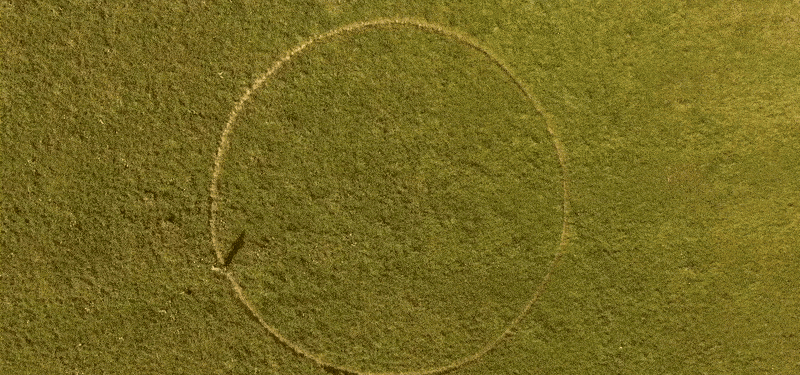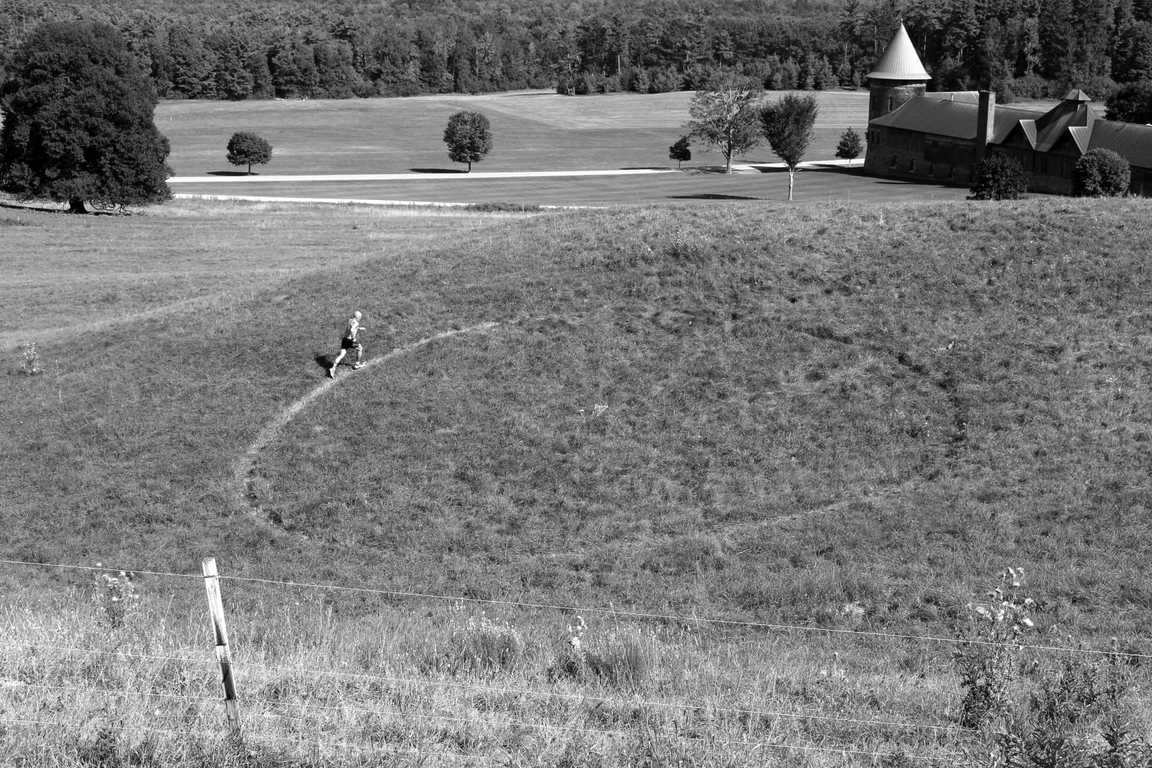
Running a Circle Clockwise (2017) - Jeroen Jongeleen
In the collection of the Museum Boijmans van Beuningen.
Upon beginning work on this case study it quickly became apparent that the main challenge was the work’s use of audio and its method of distribution over the internet. This was problematic due to a specific update in browsers called the autoplay block, which is intended to stop spam, pop-ups and other loud advertisements by recognizing the audio component and either muting or blocking it on load. LI-MA working with the artist through this case study devised a conservation strategy that suited all stakeholders involved.
Brief Description of the Work
Running A Circle Clockwise is an internet artwork created by Jeroen Jongeleen that documents the artist running a circle clockwise for 8 hours while holding a 5.5 meter radius string. Unlike with internet artworks that have generative or algorithmic attributes this artwork does not make use of a large external database. Instead, it is composed of source code, files, videos and so on which are uploaded to and stored on the server. The work consists of four videos consisting of different file formats and lengths, intended to help with accessibility from various browsers and display devices. In this way, if the browser being used is not able to read mp4 it will continue through the video files until it reaches one that it is able to read. All videos include audio, which was supplied from a microphone attached to the artist while he was running. It can be presented as an installation, either offline or online, via a projection or a screen but the browser window must be visible and the work must still be accessible online during the exhibition.
Accessibility as Resistance
In the early 2000s, Jeroen Jongeleen, was creating street art in Rotterdam, when he started to become interested in the concept of elephant paths, or unofficial routes worn down by foot traffic. Seeing these unsanctioned shortcuts in parks and public spaces, the idea of making such a path by himself began to take hold.
In 2015, he received an artist’s residency in Vermont, called “Of Land & Local” giving him the time and funding in which to explore the idea further. During that summer he created at least six running works, among which was Running A Circle Clockwise. To produce the work, he ran for 8 hours on a 5.5 meter long string which was secured by a nail driven into the ground. After establishing the desired imprint he enlisted a photographer who used a drone to take a short video of the artist reenacting the running of the work. The artist presented aerial photos from this footage at the exhibition, “Of Land and Local: A Statewide Exploration of Contemporary Art” (October 1st - October 18th, 2015), which formed the culmination of the residency. After this exhibition there was a two year incubation period where the artist continued to develop other projects before returning to Running A Circle Clockwise in 2017.

Running A Circle Clockwise (2015), the earliest iteration of the work when it was presented as aerial photos
At this time the artist described an incident with a friend, Erik van Lieshout, as forming the instigation for putting the work online. According to the artist, van Lieshout wanted to present a work of his at a given venue but was obstructed by the institution in ownership of his work from doing so. Considering this, the artist approached the programmer Thorben Jäger, Vector Explorer at 5 upLeft, to put the video online thereby bypassing traditional hierarchical systems of distribution and making Running A Circle Clockwise, accessible for all time.
Exhibiting the Running Circles Works
As an internet artwork, Running A Circle Clockwise was first presented at Art Rotterdam in 2017 where it was seen and purchased by the Museum Boijmans van Beuningen. Since its acquisition the work has not been installed. Concerning most display specifications he was flexible, except for when it came to the presentation of sound and the continued accessibility of Running A Circle Clockwise online.
Although he uses sound quite rarely in his works, the artist has stated that he includes it where it is relevant. In Running A Circle Clockwise, the audio is the sound of the artist’s breath, grounding the work in the artist’s personal experience, whereas in later works like Hydrogen Fluoride Leakage (2021) in the collection of the Kröller-Müller, the artist uses audio to place the viewer within the soundscape of the environment. Considering this, it is not surprising that the artist is specific about how this idea is relayed through presentation. Opting for muting works with sound when shown in a group, as with the presentation of the Kröller-Müller’s six running works following the idea that the sound would then distract the viewer’s concentration from the others, but choosing to show works with sound when presented alone, as they ground the viewer in the experience.
Lastly, throughout the interview the artist continued to emphasize the importance of accessibility. Regarding whether the work was presented online or offline, did not concern Jongeleen as long as it was shown within a browser window, but it was extremely important to him that the work always be accessible to online visitors. However, unfortunately at the beginning of this research, due to the auto-play block imposed by current browser versions the work’s condition did not coincide with this intention.
Preservation advice
When Jongeleen decided to put the work online in 2016 many browsers had already been updated to prevent the auto-play of media upon load, in order to block pop-ups and more generally for user comfort. Yet, for Jongeleen presenting the work as anything but a website was not an option as with proprietary video hosting platforms one relinquished intellectual rights, conflicting with the work’s intention. Therefore, Jäger had to find a way to bypass the auto-play block, which he did in 2016 by creating a script that loaded the video in a container. In this way, preventing the browser from recognizing the file as a video upon load.
This solution was sufficient until around 2022 when browser updates again prevented auto-play. At this time the Boijmans had attempted to bypass this issue, in the process changing the information in the tab to reflect the year in which the work was treated, but still the problem persisted. What Jäger proposed, and what the Boijmans executed prior to LI-MA’s restoration of the work, was to change line 30 of the index.html file so that the video was in effect muted. In most browsers settings, changing permissions to allow sound or muting the work in the code will fix the issue. However, by muting the video in order to make the work play automatically it is no longer being presented as the artist intended, especially when considering the work’s online presentation as the artist’s preferred method.
To address this, LI-MA proposed and executed another solution in consultation with the artist whereby the work plays without audio on load with a small speaker symbol in the right hand corner. When the visitor clicks on the speaker it disappears and the audio starts. The work will then continue to play on loop until the visitor closes the browser window. Changes were also made to the information in the tab so that it correctly represented the age of the work. The work was then hosted and stored on ArtHost, the source code in Gitlab and the videos in LI-MA’s digital repository as well as on LTO-8.
Access to the full case study report, interview, and object-related documents is available on request (info@li-ma.nl).
Research by LI-MA team in collaboration with: Jeroen Jongeleen (Artist), Margreet Wafelbakker (Registrar Modern Art), Marieke van Santen (Information Manager), Christel van Hees (Head of Conservation and Restoration), Roelie Zijlstra (Registrar Modern Art), , Sara Swart (Collections Data Management) all Museum Boijmans van Beuningen, Susanne Kensche (Conservator of Modern Art and Sculpture, Kröller-Müller) and Dirk van de Leemput, PhD candidate University Maastricht.








